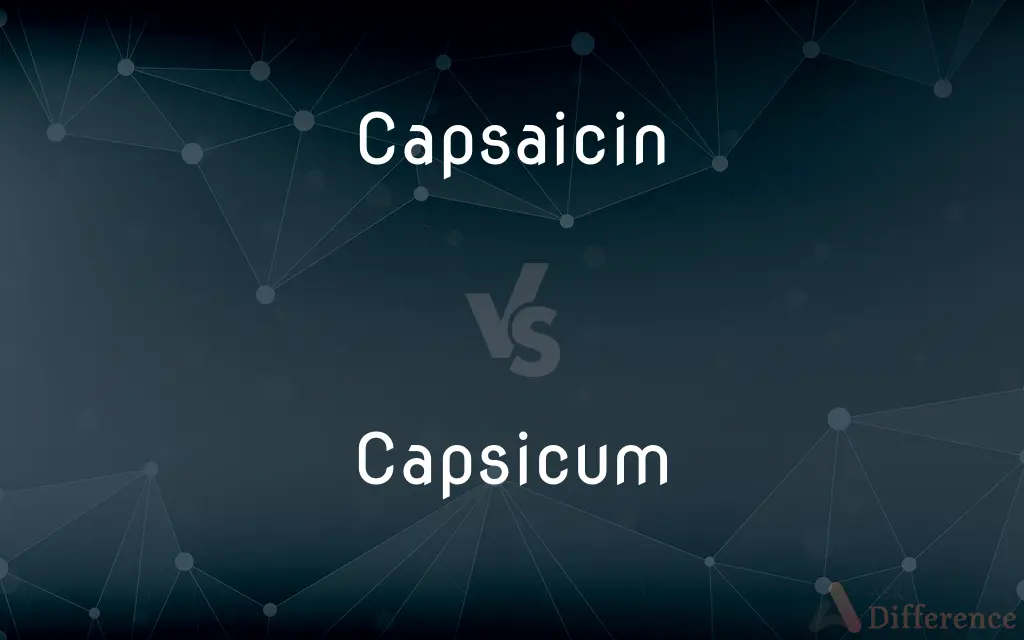Capsaicin vs. Capsicum — What's the Difference?
By Tayyaba Rehman & Urooj Arif — Updated on April 23, 2024
Capsaicin is a chemical compound responsible for the spicy heat in peppers, while capsicum refers to the entire genus of pepper plants that produce fruits with varying levels of capsaicin.

Difference Between Capsaicin and Capsicum
Table of Contents
ADVERTISEMENT
Key Differences
Capsaicin is an active component found in chili peppers that imparts the characteristic heat or spiciness when consumed. Capsicum, on the other hand, is the genus name for pepper plants, which includes a wide variety of peppers from sweet bell peppers to the intensely hot chili peppers.
The presence of capsaicin in capsicum fruits varies greatly; some capsicum varieties such as bell peppers contain negligible amounts of capsaicin, whereas others like habaneros and jalapeños contain higher levels, contributing to their spiciness.
Capsaicin is primarily concentrated in the inner membranes of fruits of the capsicum genus rather than the seeds or the outer fruit wall. This distribution plays a crucial role in the varying heat levels of different capsicum species and even individual fruits.
In terms of usage, capsaicin is extracted and used in various products such as topical ointments for pain relief, pepper sprays for self-defense, and culinary additives for heat. Conversely, capsicum fruits are used whole, either fresh, dried, or powdered, in culinary dishes worldwide to add flavor, heat, and nutritional value.
While capsaicin has been studied extensively for its potential health benefits, including pain relief and metabolic improvements, capsicum fruits also provide benefits such as high vitamin C content and other antioxidants, which vary among different capsicum species based on their capsaicin content and other phytochemical compositions.
ADVERTISEMENT
Comparison Chart
Definition
A chemical compound providing spiciness in peppers.
The genus of pepper plants, producing fruits of varying spiciness.
Location in Plant
Found in the membranes of the fruit.
Refers to the whole fruit and plant.
Usage
Used in medicines, culinary heat additives, and self-defense sprays.
Used whole in cooking and fresh produce markets.
Health Benefits
Pain relief, anti-inflammatory properties, metabolism booster.
Nutritional value from vitamins and antioxidants, dietary fiber.
Types
Pure compound, isolated for specific uses.
Includes a variety of species such as bell peppers, jalapeños, habaneros.
Compare with Definitions
Capsaicin
A chemical irritant that affects mammalian skin and mucous membranes.
Capsaicin triggers a burning sensation when it contacts human skin.
Capsicum
A genus of flowering plants in the nightshade family, known for producing peppers.
Capsicum varieties range from sweet bell peppers to fiery chilis.
Capsaicin
Used in culinary dishes to add heat.
A pinch of capsaicin can significantly increase the spiciness of any dish.
Capsicum
A source of vitamins A and C, especially high in colorful peppers.
Red bell peppers contain more vitamin C than oranges.
Capsaicin
The spicy compound found in chili peppers.
Capsaicin is used in topical creams to relieve muscle pain.
Capsicum
Includes many species with varying levels of heat.
Capsicum annuum includes both sweet peppers and hot jalapeños.
Capsaicin
Studied for its potential to reduce pain and inflammation.
Capsaicin patches are prescribed for neuropathic pain.
Capsicum
Cultivated worldwide for both culinary and ornamental purposes.
Capsicum plants are often grown in home gardens and farms.
Capsaicin
An active ingredient in pepper sprays used for self-defense.
The capsaicin in pepper spray causes temporary blindness and pain.
Capsicum
Used in cooking to add flavor and color to dishes.
Capsicum is a staple in salsa and many spicy cuisines.
Capsaicin
A pungent alkaloid, C18H27NO3, derived from certain capsicums that is a strong irritant to skin and mucous membranes and is used in some topical pain relievers and in pepper sprays.
Capsicum
Capsicum () is a genus of flowering plants in the nightshade family Solanaceae, native to the Americas, cultivated worldwide for their chili pepper or bell pepper fruit.
Capsaicin
(organic compound) A chemical compound found in chilli peppers, which is responsible for their pungent flavor.
Capsicum
Any of various tropical American pepper plants of the genus Capsicum, especially any of the numerous cultivated forms of the species C. annuum and C. frutescens.
Capsaicin
A colorless crystalline substance extracted from the Capsicum annuum, and giving off vapors of intense acridity.
Capsicum
The fruit of any of these plants, especially the dried pungent types used as a condiment and in medicine.
Capsaicin
Colorless pungent crystalline compound derived from capsicum; source of the hotness of hot peppers of the genus Capsicum such as chili and cayenne and jalapeno
Capsicum
Any of several tropical American plants, of the genus Capsicum, principally the species Capsicum annuum and Capsicum frutescens, that are cultivated as edible peppers.
Capsicum
The spicy fruit of the above plants, the bell pepper.
Capsicum
A genus of plants of many species, producing capsules or dry berries of various forms, which have an exceedingly pungent, biting taste, and when ground form the red or Cayenne pepper of commerce.
Capsicum
Any plant of the genus Capsicum (of the Solanaceae family, which are unrelated to Piper), and its fruit; red pepper; chili pepper; as, the bell pepper and the jalapeno pepper (both Capsicum annuum) and the habanero pepper (Capsicum chinense); .
Capsicum
Any of various tropical plants of the genus Capsicum bearing peppers
Common Curiosities
What exactly is capsaicin?
Capsaicin is the chemical compound that gives hot peppers their characteristic heat.
How does capsicum differ from capsaicin?
Capsicum is the plant and fruit, while capsaicin is a chemical component found within the plant.
Are all capsicum fruits spicy?
No, the spiciness varies; some capsicum varieties like bell peppers have almost no capsaicin.
Can capsaicin help with weight loss?
Some studies suggest capsaicin can boost metabolism, potentially aiding in weight loss.
Is capsaicin harmful?
In high concentrations or direct contact with eyes and skin, it can be irritating.
Can eating capsicum fruits provide health benefits?
Yes, they offer vitamins, antioxidants, and dietary fiber.
How is capsaicin used in medicine?
It is used in topical ointments and patches for pain relief and anti-inflammatory purposes.
How does capsaicin affect the body?
It binds to pain receptors, causing a burning sensation but also potential pain relief.
Why do some peppers feel hotter than others?
The heat level depends on the capsaicin content, which varies among different capsicum species.
What kinds of capsicum are there?
Capsicum includes many species like bell peppers, jalapeños, and habaneros.
What is the best way to mitigate the burn from capsaicin?
Consuming dairy products like milk can help soothe the burning sensation.
What is the nutritional value of capsicum?
Capsicum is high in vitamins A and C, and contains other nutrients depending on the variety.
How can one reduce the spiciness of a capsicum dish?
Removing the seeds and membranes where capsaicin is concentrated can reduce the heat.
How should capsicum be stored to maintain freshness?
Store in a cool, dry place or refrigerate to extend freshness.
Are there any risks associated with consuming too much capsicum?
Excessive consumption can lead to gastrointestinal discomfort in sensitive individuals.
Share Your Discovery

Previous Comparison
Account vs. Satisfactory
Next Comparison
Consistent vs. ContinuousAuthor Spotlight
Written by
Tayyaba RehmanTayyaba Rehman is a distinguished writer, currently serving as a primary contributor to askdifference.com. As a researcher in semantics and etymology, Tayyaba's passion for the complexity of languages and their distinctions has found a perfect home on the platform. Tayyaba delves into the intricacies of language, distinguishing between commonly confused words and phrases, thereby providing clarity for readers worldwide.
Co-written by
Urooj ArifUrooj is a skilled content writer at Ask Difference, known for her exceptional ability to simplify complex topics into engaging and informative content. With a passion for research and a flair for clear, concise writing, she consistently delivers articles that resonate with our diverse audience.














































